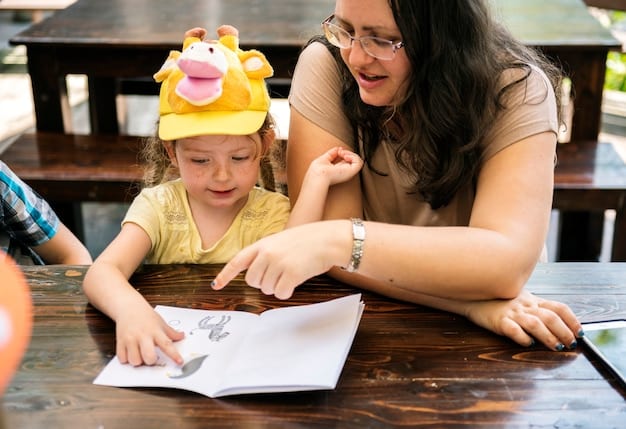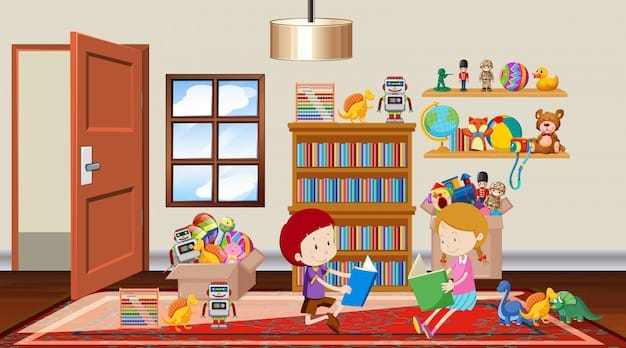Raising Bilingual Children: Insider Tips for US Parents

Raising bilingual children involves strategic language exposure, consistent practice, and creating a supportive environment that celebrates both languages, fostering cognitive benefits and enhanced cultural awareness.
Are you an American parent considering raising bilingual children? It’s a rewarding journey, but it comes with its own set of challenges and triumphs. Here are insider tips to help you navigate the path to language acquisition success.
Understanding the Benefits of Bilingualism
Bilingualism offers a multitude of advantages for children, extending far beyond just the ability to speak two languages. Understanding these benefits can provide you with the motivation and perspective needed to navigate the journey of raising bilingual children successfully.
Let’s explore some key advantages:
Cognitive Advantages
Studies have shown that bilingual children often exhibit enhanced cognitive flexibility, problem-solving skills, and multitasking abilities. This is because their brains are constantly switching between two languages, strengthening cognitive functions.
Academic Benefits
Bilingualism can positively impact academic performance, particularly in areas like reading and language arts. A deeper understanding of language structure and grammar often translates to better comprehension and communication skills.

Cultural Awareness
Learning another language opens doors to another culture, fostering greater empathy, understanding, and appreciation for diversity. This broader perspective can be invaluable in today’s interconnected world.
- Improved Communication Skills: Bilingual children often develop heightened awareness of language nuances and communication styles.
- Enhanced Memory: Regularly using two languages can strengthen memory capacity and recall abilities.
- Future Opportunities: Bilingualism opens doors to a wider range of career and travel opportunities.
In conclusion, understanding the profound benefits of bilingualism is crucial for parents embarking on this journey. The cognitive, academic, and cultural advantages make the effort well worth it, setting your child up for a lifetime of success and enriched experiences.
Creating a Language-Rich Environment at Home
One of the most critical factors in successfully raising bilingual children is creating a language-rich environment at home. This involves strategically exposing your child to both languages in a consistent and engaging manner.
Here’s how you can do it:
Language Exposure Strategies
Implement strategies like “one parent, one language” (OPOL), where each parent consistently speaks to the child in a different language. Alternatively, you can designate specific times or days for each language.
Immersive Activities
Incorporate both languages into daily activities, such as reading books, singing songs, playing games, and even cooking meals together. Make language learning fun and engaging.
Access to Resources
Provide plenty of resources in both languages, including books, movies, music, and educational apps. Ensure that your child has access to a variety of materials to support their language development.

- Consistent Language Input: Ensure regular and consistent exposure to both languages.
- Engaging Activities: Make language learning enjoyable through games, songs, and stories.
- Cultural Immersion: Expose your child to the cultures associated with each language through food, festivals, and traditions.
In conclusion, creating a language-rich environment at home is essential for raising bilingual children. By implementing consistent strategies, incorporating immersive activities, and providing access to resources, you can create a supportive environment that fosters language acquisition success.
Effective Strategies for Language Acquisition
Raising bilingual children requires the implementation of effective strategies that support language acquisition. These strategies should be tailored to your child’s individual learning style and preferences, ensuring that they remain engaged and motivated.
Here are some proven techniques:
Use of Technology
Leverage technology to enhance language learning. Educational apps, online games, and interactive platforms can provide engaging and interactive opportunities for language practice.
Early Introduction
Start introducing both languages from a young age. Young children have a remarkable capacity for language learning, and early exposure can set them up for success.
Focus on Communication
Prioritize communication over perfection. Encourage your child to use both languages freely, even if they make mistakes. Correct mistakes gently and focus on fostering confidence in their communication abilities.
Effective strategies for language acquisition are vital to raising bilingual children. By using technology, introducing languages early, and focusing on communication, you can create a supportive environment that fosters language development. Remember to be patient and celebrate your child’s progress along the way.
Overcoming Common Challenges
Raising bilingual children is not without its challenges. It’s important to be aware of these potential hurdles and develop strategies for overcoming them. Some common challenges include language mixing, resistance to speaking one language, and maintaining motivation.
Here’s how to address them:
Addressing Language Mixing
Language mixing, also known as code-switching, is a common phenomenon in bilingual children. While it’s often a natural part of their language development, it’s important to encourage them to differentiate between the two languages. Gently remind them to use the appropriate language in different contexts.
Motivating Language Use
Some children may resist speaking one of the languages, especially if they perceive it as being less “cool” or less useful. Make the language fun and relevant to their interests. Connect them with other children who speak the language, and expose them to positive cultural experiences.
Maintaining Consistency
It can be challenging to maintain consistency in language exposure, especially when life gets busy. However, consistency is key to language acquisition success. Set realistic goals and prioritize language learning activities.
- Patience and Encouragement: Be patient with your child and offer plenty of encouragement.
- Positive Reinforcement: Celebrate their progress and reward their efforts.
- Seek Support: Connect with other bilingual families for support and advice.
Overcoming common challenges requires patience, understanding, and proactive strategies. By addressing language mixing, motivating language use, and maintaining consistency, you can navigate the hurdles and help your child thrive in their bilingual journey.
The Role of Parental Involvement
Parental involvement plays a crucial role in the success of raising bilingual children. Your active participation, encouragement, and support can significantly impact your child’s language development and motivation.
Here’s how you can get involved:
Active Participation
Actively participate in language learning activities with your child. Read books together, sing songs, play games, and engage in conversations in both languages.
Positive Reinforcement
Provide plenty of positive reinforcement and encouragement. Celebrate your child’s progress and acknowledge their efforts. Let them know that you value their bilingual abilities.
Creating Opportunities
Create opportunities for your child to use both languages in real-world situations. Take them to cultural events, connect them with other bilingual speakers, and encourage them to use their language skills when traveling.
Parental involvement is essential for raising bilingual children. By actively participating, providing positive reinforcement, and creating opportunities for language use, you can significantly contribute to your child’s language acquisition success. Your support and encouragement will empower them to embrace their bilingual identity.
Assessing and Celebrating Progress
Regularly assessing your child’s progress and celebrating their achievements is an important part of raising bilingual children. It allows you to track their development, identify areas where they may need additional support, and provide them with the motivation to continue learning.
Here’s how to do it effectively:
Tracking Milestones
Keep track of your child’s language milestones, such as their ability to understand and use new vocabulary, construct sentences, and engage in conversations. Celebrate each milestone as a significant achievement.
Informal Assessments
Conduct informal assessments to gauge your child’s language proficiency. This can involve asking them questions in both languages, reading books together, or engaging in role-playing activities.
- Regular Celebrations: Celebrate their language skills and cultural identity with parties, gatherings, and cultural events.
- Positive Feedback: Provide them with positive feedback on their language skills.
Assessing and celebrating progress is about providing motivation for raising bilingual children. It’s essential for fostering confidence and encouragement, as positivity pushes children towards language acquisition successfully.
| Key Concept | Brief Description |
|---|---|
| 🗣️ Language Exposure | Immerse your child in both languages consistently. |
| 🎉 Celebrate Success | Acknowledge and celebrate milestones for encouragement. |
| 📚 Use of Technology | Leverage educational apps for language practice. |
| 👨👩👧👦 Parental Involvement | Active participation significantly boosts learning. |
Frequently Asked Questions (FAQs)
▼
The earlier, the better! Introducing a second language from infancy allows children to absorb it naturally, similar to their native tongue. Starting before the age of 3 is often recommended for optimal results.
▼
Surround your child with the target language through books, music, movies, and interactions with native speakers. Make language learning fun and integrate it into daily activities to create a positive association.
▼
Mixing languages is a normal part of bilingual development. Gently encourage your child to use the correct vocabulary, but avoid scolding them. Focus on providing clear and consistent language input.
▼
Make language learning enjoyable and relevant to your child’s interests. Celebrate their progress, provide positive reinforcement, and create opportunities for them to use their language skills in meaningful ways.
▼
Yes, it’s possible! You can enroll your child in language classes, hire a tutor, or expose them to immersive environments through language camps or cultural events. Your support and encouragement are still crucial.
Conclusion
In conclusion, raising bilingual children is an enriching experience that offers numerous cognitive, academic, and cultural benefits. By creating a language-rich environment, implementing effective strategies, and actively participating in their language learning journey, you can set your child up for success in today’s globalized world.





